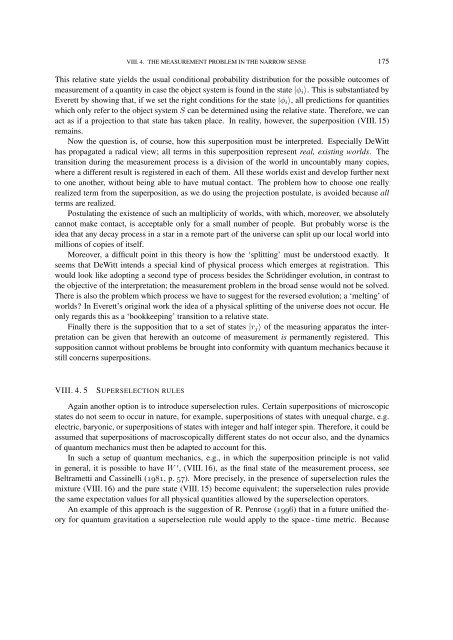FOUNDATIONS OF QUANTUM MECHANICS
FOUNDATIONS OF QUANTUM MECHANICS
FOUNDATIONS OF QUANTUM MECHANICS
You also want an ePaper? Increase the reach of your titles
YUMPU automatically turns print PDFs into web optimized ePapers that Google loves.
VIII. 4. THE MEASUREMENT PROBLEM IN THE NARROW SENSE 175<br />
This relative state yields the usual conditional probability distribution for the possible outcomes of<br />
measurement of a quantity in case the object system is found in the state |ϕ i ⟩. This is substantiated by<br />
Everett by showing that, if we set the right conditions for the state |ϕ i ⟩, all predictions for quantities<br />
which only refer to the object system S can be determined using the relative state. Therefore, we can<br />
act as if a projection to that state has taken place. In reality, however, the superposition (VIII. 15)<br />
remains.<br />
Now the question is, of course, how this superposition must be interpreted. Especially DeWitt<br />
has propagated a radical view; all terms in this superposition represent real, existing worlds. The<br />
transition during the measurement process is a division of the world in uncountably many copies,<br />
where a different result is registered in each of them. All these worlds exist and develop further next<br />
to one another, without being able to have mutual contact. The problem how to choose one really<br />
realized term from the superposition, as we do using the projection postulate, is avoided because all<br />
terms are realized.<br />
Postulating the existence of such an multiplicity of worlds, with which, moreover, we absolutely<br />
cannot make contact, is acceptable only for a small number of people. But probably worse is the<br />
idea that any decay process in a star in a remote part of the universe can split up our local world into<br />
millions of copies of itself.<br />
Moreover, a difficult point in this theory is how the ‘splitting’ must be understood exactly. It<br />
seems that DeWitt intends a special kind of physical process which emerges at registration. This<br />
would look like adopting a second type of process besides the Schrödinger evolution, in contrast to<br />
the objective of the interpretation; the measurement problem in the broad sense would not be solved.<br />
There is also the problem which process we have to suggest for the reversed evolution; a ‘melting’ of<br />
worlds? In Everett’s original work the idea of a physical splitting of the universe does not occur. He<br />
only regards this as a ‘bookkeeping’ transition to a relative state.<br />
Finally there is the supposition that to a set of states |r j ⟩ of the measuring apparatus the interpretation<br />
can be given that herewith an outcome of measurement is permanently registered. This<br />
supposition cannot without problems be brought into conformity with quantum mechanics because it<br />
still concerns superpositions.<br />
VIII. 4. 5<br />
SUPERSELECTION RULES<br />
Again another option is to introduce superselection rules. Certain superpositions of microscopic<br />
states do not seem to occur in nature, for example, superpositions of states with unequal charge, e.g.<br />
electric, baryonic, or superpositions of states with integer and half integer spin. Therefore, it could be<br />
assumed that superpositions of macroscopically different states do not occur also, and the dynamics<br />
of quantum mechanics must then be adapted to account for this.<br />
In such a setup of quantum mechanics, e.g., in which the superposition principle is not valid<br />
in general, it is possible to have W ′ , (VIII. 16), as the final state of the measurement process, see<br />
Beltrametti and Cassinelli (1981, p. 57). More precisely, in the presence of superselection rules the<br />
mixture (VIII. 16) and the pure state (VIII. 15) become equivalent; the superselection rules provide<br />
the same expectation values for all physical quantities allowed by the superselection operators.<br />
An example of this approach is the suggestion of R. Penrose (1996) that in a future unified theory<br />
for quantum gravitation a superselection rule would apply to the space - time metric. Because
















